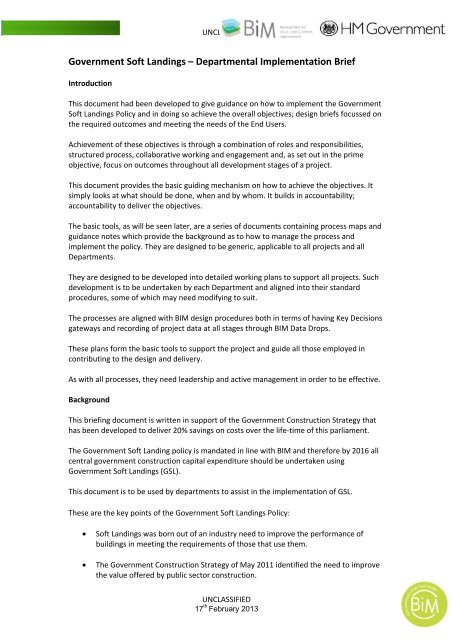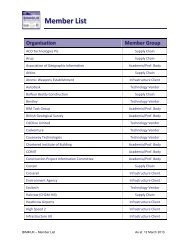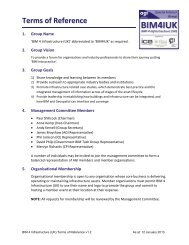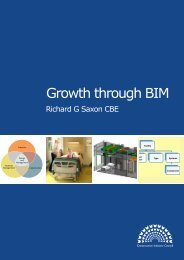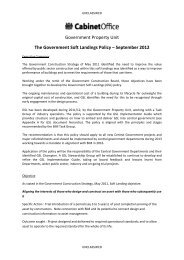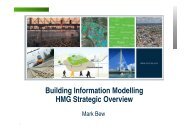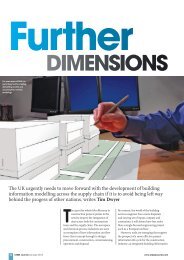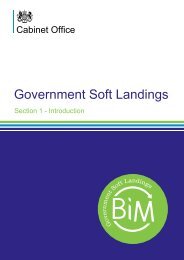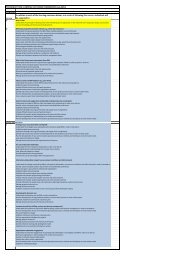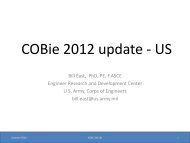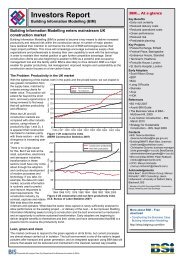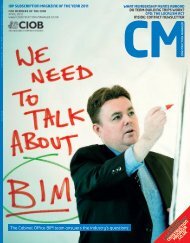Government Soft Landings â Departmental ... - BIM Task Group
Government Soft Landings â Departmental ... - BIM Task Group
Government Soft Landings â Departmental ... - BIM Task Group
- No tags were found...
You also want an ePaper? Increase the reach of your titles
YUMPU automatically turns print PDFs into web optimized ePapers that Google loves.
UNCLASSIFIED• Working under the remit of the <strong>Government</strong> Construction Board, these objectiveshave been brought together to develop the <strong>Government</strong> <strong>Soft</strong> <strong>Landings</strong> policy.• The policy, agreed by the <strong>Government</strong> Construction Board in September 2012, isaligned in principle with the findings and recommendations of the <strong>BIM</strong> <strong>Task</strong> <strong>Group</strong>.• Application of the policy will be the responsibility of the Central <strong>Government</strong>Departments. A <strong>Government</strong> <strong>Soft</strong> <strong>Landings</strong> Stewardship <strong>Group</strong> will be established tocontinue to develop and refine the Implementation Plan, taking on board feedbackfrom the Departments and on-going trial projects.<strong>Government</strong> <strong>Soft</strong> <strong>Landings</strong> has been developed to focus on two of the key objectives of the<strong>Government</strong> Construction Strategy:“Clients issue a brief that concentrates on required performance and outcome; designers andconstructors work together to develop an integrated solution that best meets the requiredoutcome”“The alignment of interest between those who design and construct a facility and those whosubsequently occupy and manage it”The approach taken was to use the <strong>Soft</strong> <strong>Landings</strong> principles, focussing on; the requiredperformance of buildings, End User engagement across all the key stages of development,effective handover and aftercare, the use of feedback and occupancy evaluation to improvequality and inform design decisions.The challengeAdopting a new asset should be a positive experience. However, the gap between theclient/design expectations and delivered performance is often very significant, e.g.- Planning for asset management does not start early enough leading to wasted timeand resource before the asset becomes fully operational.- The transition from completion to operation often takes considerable time, effortand resource before the predicted performance is achieved.- Quite often, actual performance, especially energy, does not match the predictedperformance.- Aspects of user and maintainer needs are often overlooked resulting in additionalexpenditure being required to enable the required business functions to beconducted.- Understanding how the asset should operate is often a costly process of trial anderror.The Opportunity<strong>Government</strong> <strong>Soft</strong> <strong>Landings</strong> (GSL) is to be used to bridge the gap between expectation andreality by engaging users and operators to review and comment upon the design,construction, commissioning and handover proposals. Adopting an approach that trulyaddresses outcomes required and how they will be delivered and assessed. EnablingUNCLASSIFIED17 th February 2013
UNCLASSIFIED• Aftercare and Post Occupancy EvaluationSupporting the needs of the End Users, evaluating success in project delivery, lessonslearnt and knowledge share• Performance ManagementEvaluating the success of the finished product and the performance of the team indelivering it.• Contracts and ProcurementIdentify and build in the project specific needs into the procurement process.Roles and ResponsibilitiesFundamental to the concept of <strong>Government</strong> <strong>Soft</strong> <strong>Landings</strong> is collaborative working and keystakeholder engagement at all stages of the process. The Guiding Principles are:• Leadership – Accountability and Responsibility at all stages• Engagement – Integration of End Users into the design and validation process• Focus on outcomes – Evaluate throughout the development process• Support – Support to the End Users through a structured Aftercare PlanIn the process maps the following key roles are identified as fundamental to the process:1. Project Sponsor• Ultimate Accountability into the Department for the success of the project• Sign off to all key stages of the development programme, from concept through topost occupancy evaluation• Establishes the key requirements of the Project Brief• Identifies the key stakeholders2. Project Manager• Accountable to the Project Sponsor• Responsibility for all aspects of delivery of the project; scope, design, budget,programme, health and safety• Ensures that each stage of the project is managed in accordance with the ProcessMap and closed out with Project Sponsor approval• Engages with the design and construction team to embed <strong>Government</strong> <strong>Soft</strong> <strong>Landings</strong>into design briefs and• Establishes SMART objectives and validates all decisions against them• Establishes Performance Targets and monitors against them• Develops and manages an Aftercare Plan, inclusive of Post Occupancy Evaluationstudies to ensure the building is optimised, all End User needs have been met andthe project is satisfactorily closed out• Delivers feedback reports to ensure lessons learnt are transferred to other projects3. <strong>Government</strong> <strong>Soft</strong> <strong>Landings</strong> (GSL) Champion• Represents the needs of the End Users; Occupiers, Visitors and Facilities Managers• Actively engages with the End Users to ensure their needs are input into all stages ofthe projectUNCLASSIFIED17 th February 2013
UNCLASSIFIEDObjectives and practical considerations are also contained in the plan guidance notes.To support the Aftercare Process it is essential to carry out Post Occupancy Surveys.<strong>Government</strong> <strong>Soft</strong> <strong>Landings</strong> does not predetermine the format of such surveys, it does giveguidance on what should be done. For complex projects there are survey tools available.Specific to environmental, CIBSE TM22 should be used.In its simplest form, Post Occupancy Evaluation can be in the form of simple reviewmeetings with End Users and relevant members of the project teamFuture standardisation of the survey techniques will lead to regularisation of informationbeing produced, leading to improved feedback and knowledge share. Further work todevelop standard Post Occupancy Evaluation is currently underway.UNCLASSIFIED17 th February 2013
UNCLASSIFIEDPerformance ManagementPerformance Management is intrinsically built in to <strong>Government</strong> <strong>Soft</strong> <strong>Landings</strong> through acombination of the process being fundamentally outcome driven, the establishment ofobjectives across the key focus areas and the requirement for post occupancy evaluation;set objectives and measure the results.The drive for continuous improvement, through evaluation and knowledge share, is alsosupported by the collaborative principles established in the document. This is integralthroughout the process.The policy establishes the need to set performance targets, validate throughout the designstages and evaluate post occupancy as the buildings come into use. Such evaluation shouldbe continued during the first 3 years of occupancy. The core purpose is to ensure thebuildings are optimised to meet the needs of the End Users. Clearly, the survey resultsshould also be used to provide feedback, to enable informed design decisions on futureprojects and assess the performance of the project team in delivering the objectives of thebriefThere are two aspects to evaluate through Performance Management:1. The quality of the finished product2. The performance of the team in managing and delivering the project.The first element is built in to the process through the occupancy survey requirements. Thishas been covered in the previous section; Aftercare and Post Occupancy Evaluation. It isbuilt into all of the process mapsDirections around performance management of the team are less specific, there is moreflexibility to vary the requirements to suit the individual needs of each project. This is bydesign; the prime objective of <strong>Government</strong> <strong>Soft</strong> <strong>Landings</strong> is to deliver the right solution andmeet the needs of the End Users.Success in delivering <strong>Government</strong> <strong>Soft</strong> <strong>Landings</strong> needs a base of Contractors and Consultantswho can work to the guiding principles. Clearly, <strong>Government</strong> <strong>Soft</strong> <strong>Landings</strong> gives clearobjectives and performance targets on which the supplier base can be measured. These area combination of hard measures; meeting environmental targets, delivering fully populatedasset registers and softer targets; engagement and collaboration.In summary, each project should have a performance measurement built in; the actual detailshould be project specific.Performance analysis should feedback into <strong>Departmental</strong> procurement processes. Rewardgood teams through recognition and the potential for increased opportunity. Engage with,and seek improvement from, poor performing suppliers.UNCLASSIFIED17 th February 2013
UNCLASSIFIEDContracts and Procurement<strong>Government</strong> <strong>Soft</strong> <strong>Landings</strong> does not significantly affect standard procurement processes andcontract conditions.As with all contracts, specific <strong>Departmental</strong> or project requirements are built into thecontracts. <strong>Government</strong> <strong>Soft</strong> <strong>Landings</strong> is just part of this procurement process. The need todesign for the project specific requirements is built into the early stages of each of theprocess maps. It is a simple concept, based around defining the needs prior to procurement,embedding targets and support requirements into the scope of works, specifications andplan of works.Typical examples are:1. Aftercare. Specific requirements for attendance and support for the Aftercare period areto be designed by the Project Manager and then embedded into procurement documents.This is likely to seek engagement beyond Practical Completion and standard Defects LiabilityPeriods.2. Asset Registers. The requirement for supply of Asset Register information, issued directlyinto the project database, should be built into the scope of works and specifications for allsuppliers.3. Environmental. Evaluation and monitoring against the design targets should be identifiedas a contract requirement for relevant consultants and suppliers.Probably the most important requirement is to engage in collaborative behaviour. This canbe set as a performance objective; it can be measured and evaluated.In summary, the procurement of <strong>Government</strong> <strong>Soft</strong> <strong>Landings</strong> is inherent and built in throughworking with the process maps and guidance documents.Defects liability periods and Warranty provisions can be extended to support the principles ifrequired, possibly focussed on critical areas. Any such decision needs to be made inconjunction with a review of retention provision.<strong>Government</strong> <strong>Soft</strong> <strong>Landings</strong> does not at this stage predetermine how this should be managedwithin each Department. There are examples, such as Procure21+ where two year defectsliability periods supported by zero retention provision appear successful.GSL StewardshipThe <strong>Government</strong> <strong>Soft</strong> <strong>Landings</strong> Stewardship <strong>Group</strong> will be established to provide a route forfeedback on how the policy has been implemented, sharing lessons learnt acrossDepartments and, initially, to be the central base for continued improvement anddevelopment of the Implementation Plan; processes maps and guidance notes.Initially, the Stewardship <strong>Group</strong> will be focussed on working with a series of trial projectsacross various <strong>Government</strong> Departments.UNCLASSIFIED17 th February 2013
UNCLASSIFIEDReferences and Alignment<strong>Government</strong> <strong>Soft</strong> <strong>Landings</strong> is designed to be aligned with industry legislative requirementsand best practice guidelines. Specific references are included in the Process Maps andGuidance Documents.The following general documents and codes should also be referenced in developing thedetailed Implementation Plans:• Requirements and obligations under the Construction (Design and Management)Regulations:2007 are unaffected and need to be managed in parallel with the GSLprocesses; they are naturally aligned and are mutually beneficial• BS8536:2010 Facilities Management Briefing - This standard gives recommendationsfor facility management briefing to ensure that design takes account of the expectedperformance of the facility in use.• The <strong>Soft</strong> <strong>Landings</strong> Framework – BSRIA BG 4/2009The <strong>Soft</strong> <strong>Landings</strong> Core Principles – BSRIA BG38/2012The <strong>Government</strong> Construction Strategy, from which the policy was founded, is foundthrough the following link.http://www.cabinetoffice.gov.uk/sites/default/files/resources/<strong>Government</strong>-Construction-Strategy_0.pdfMore InformationMore information about GSL can be found on the following web-site;www.bimtaskgroup.org..uk/GSL .<strong>Government</strong> <strong>Soft</strong> <strong>Landings</strong> is founded upon the principles of <strong>Soft</strong> <strong>Landings</strong> and has beeninformed by this. Information on <strong>Soft</strong> <strong>Landings</strong> can be found at the BSRIA web-site.http://www.bsria.co.uk/services/design/soft-landings/UNCLASSIFIED17 th February 2013


